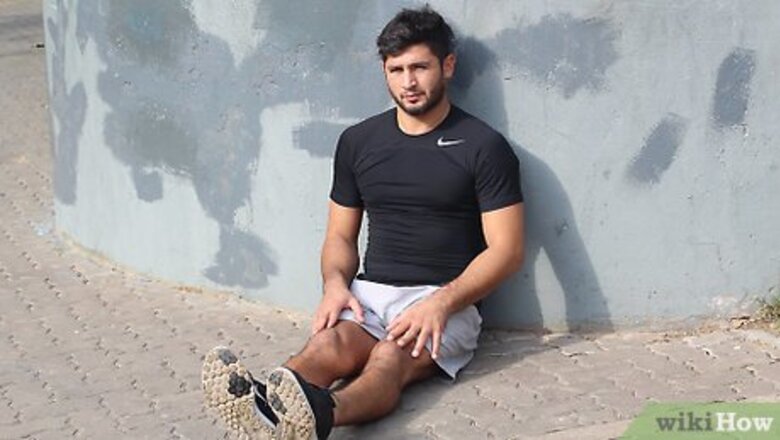
views
Doing a Handstand

Sit with your back against the wall and legs straight in front of you. To start, you should get in the right position. Make sure you have a yoga mat or gym mat to work on in case you slip or fall. Place the mat before a wall and sit down. Sit with your back pressed against the wall. Stretch your legs straight out in front of you and raise your arms above your head. You should form the shape of an "L." There should be a roughly 90 degree angle forming at your waist.
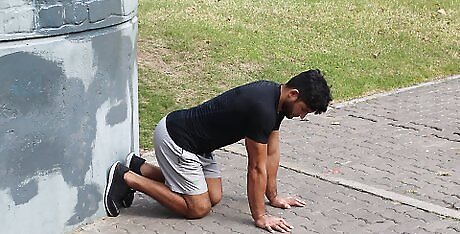
Get on all fours. Once you've gotten into the above 90 degree angle, you'll need to get on all fours. You want to place your hands on the ground roughly where you heels were in the first position. This will allow you to guide yourself up the wall safely when performing a handstand. The soles of your feet should be pressed against the wall. Keep your arms straight and spread your fingers out. Pull your shoulders back, drawing them out as to broaden your collarbone.
Push your bottom in the air. To shift into the headstand position, pull your bottom into the air while straightening your legs and arms. As you do so, tuck your toes onto the floor so your feet spread against the wall. This will look something like the downward dog position, if you're familiar with yoga.
Walk your feet a few feet up the wall. Now, you can begin shifting into the headstand position. Place one foot up the wall, curling your toes as you go. Lift your foot until it's about the height of your hips. When you feel balanced and secure, lift your other foot up until it's about hip height as well. Straighten your legs. This will push your bottom away from the wall, which may feel frightening. Try to stay calm as you go, remembering to breathe on occasion. Try to form a roughly 90 degree angle. It's similar to the position you started in, only reversed. Hold this until you feel comfortable and balanced enough to continue.
Continue walking up the wall until you're doing a handstand. Keep moving your feet up the wall. As you go, you'll have to move your hands closer to the wall for safety and balance. Keep going until your body forms a straight line parallel to the wall, with the tips of your toes touching the wall. You may have to stick to a 90 degree angle for your first few attempts.
Warming Up
Stretch your wrists. Before attempting to do a handstand, you should stretch your wrists. Your wrist undergo a lot of pressure during a handstand. If you do not warm up first, you could end up feeling sore afterwards. Stand on your hands and knees, placing most of your weight on your knees. Hold your hands forward with your fingers touching the ground. Gently rock back and forth on your knees, alternating the weight you're placing on your fingers. Then, put your hands flat on the ground. Shift your body weight on your hands. Then, lift your palms up and down, raising your body with the motion. Do this about 10 times. After this, repeat the same basic motion but roll your palms back and forth as you lift. You want to shift weight between the different joints of your fingers. Do this 10 times, while rolling your palms.
Prep your shoulders. Your shoulders also carry a lot of weight during a handstand. You want to make sure you warm them up properly before attempting a handstand. Once again, get on all fours with your fingers spread slightly apart. Going slowly, rotate both your elbows. Try to move your elbow as much as possible, moving it from the back of your body to the front. Keep your arms straight as you go. Move your hands so your fingers are pointing out to the side of your body. Push your body back and forth, shifting your weight from one hand to the other. Keep the heel of your hand on the ground. Make sure the heel holds most of your weight. Shift your fingers so they're facing your knees. Keep the heel of your hand on the ground. Shift your weight up and down, keeping your arms straight. Repeat about 15 times. Strengthen your shoulders by working your serratus and intercostal muscles. One way to work these muscles is by holding onto a pole with both hands and using your shoulder muscles to pull up your bodyweight a few inches.
Practice with a headstand. Handstands can be intimidating because being upside down is uncomfortable. Before doing a handstand, try practicing with a headstand. Sit in front of a sturdy wall. Place your hands on the ground, about shoulder width apart. Place your head on the ground in front of your hands, forming a triangle. Kick one leg forward and then the other, transferring your weight onto your hands, head, and shoulders. Hold for as long as you can, breathing as necessary. Allow your legs to lean onto the wall for support.
Taking Safety Precautions
Move up slowly. If you've never done a handstand before, you need to work your way up to the routine. Do not attempt a full handstand right away. Spend a few weeks practicing headstands and forming 90 degree angles against the wall. This will get you used to the feeling of being upside down. It will also help you build the muscles necessary to do a full handstand. You might also want to strengthen your arms. Try lifting weights or doing push ups a couple of times a week to build up your muscles.
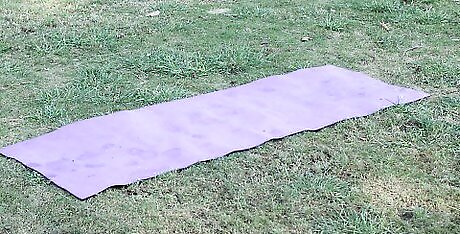
Use a mat. You should not be practicing handstands without a mat underneath you. In the event you do lose your balance and fall, a mat can help prevent injury. It may be a good idea to practice in a gym at first. There should be mats in place.
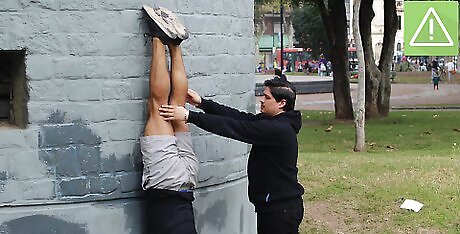
Have a friend spot you. You should not start off doing handstands completely alone, even on the wall. A friend can help hold your legs to help you find your balance, and pull your legs up on the wall. He or she can also help catch you in the event you lose your balance. When you first start doing handstands, do so with the assistance of a friend.











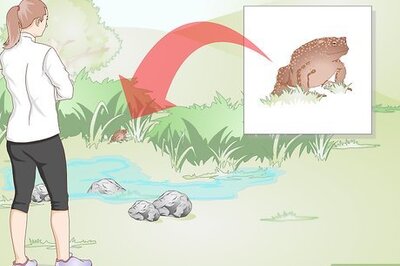








Comments
0 comment